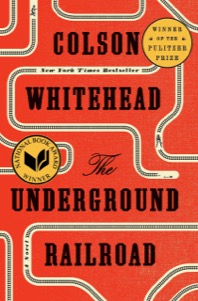Colson Whitehead had the idea for The Underground Railroad about 15 years before the book was actually written. When he finally convinced himself to write it, he immersed himself in research, determined to do justice to the difficult topics the book explores.
It shows. This is a brutal novel, with some absolutely terrible scenes that will be uncomfortable for everyone, and almost certainly too much for some.
Technically, The Underground Railroad is science-fiction. The railroad in the book is an actual subway, and as you move from stop to stop, each stop has subtle indications that time may have leaped forward a bit as well. But that aspect of the story is very subdued. Like the doors in Exit West, the fantastical nature of the railroad serves as a device to let Colson get his characters to the next destination so that he can explore racism through a variety of lenses.
The story starts on a plantation, where we meet Cora and the other characters that will drive the story forward. This setting, in particular, is evidence of the incredible amount of research that went into the book. Colson’s presentation of plantation life goes beyond the shallow perspective we often get. He explores what a complete lack of power and humanity does to those enslaved, and how that causes many of the slaves to treat each other poorly as well—desperate to be able to assert some sort of control or to be able to call something theirs. It’s chilling and heartwrenching. It also sets up the mystery of Cora’s mother (when we finally find out her story late in the novel, it’s a significant and poignant moment).
When Cora eventually runs away with another slave named Ceaser, we’re moved first to South Carolina. South Carolina serves as our window into governmental attempts to intervene with race, and we quickly see just how awful their attempts are.
Each successive stop provides a different view. South Carolina explores government intervention. North Carolina is like a scene from a horror movie as it deals with white supremacy. Indiana provides a little bit of a respite as we see how the characters (nearly all former slaves) attempt to reclaim their lives and their humanity. But even Indiana isn’t as gentle as it first seems.
Without spoiling the ending, I will say that it ends in the only way a book like this could end. There’s hope, in the end, but it’s a heavy hope that is buoyed by the reality that the scars of Cora’s experience (and more generally, racism) run deep and linger on.
Whitehead’s writing is beautiful and poignant. I’ve seen lesser books on difficult subjects struggle with finding the right balance between telling their story without belaboring their message. Whitehead doesn’t have a problem with that. You’re absorbed in the story from the beginning and you can’t help but see all the painful parallels to what is still happening today.
The railroad in the book doesn’t ever stop in today’s day and age, but you end up finding your way there nonetheless.
